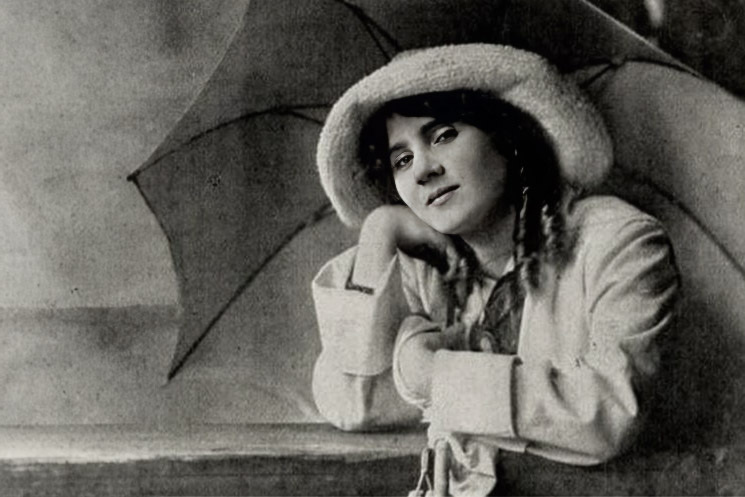Florence Lawrence Biography
Today, it’s common to see actors hounded by the press, appearing on talk shows to promote their films, and striding down the red carpet at movie premieres. But in the early days of cinema, none of that existed. Before Hollywood rose to prominence and films were made on the East Coast instead of the West, the movie industry was in its infancy. Most films were short, one- or two-reel productions. This is where Florence Lawrence got her start.
Often referred to as “the first movie star” and known as “The Biograph Girl,” Florence Lawrence was the first actress to be publicly recognized by name. Her fame was so significant that studios began using her name to promote films, a novelty at a time when actors typically remained uncredited. Over the course of her career, she appeared in over 300 films before her tragic death in 1938.
Early Life
Born Florence Annie Bridgwood on January 2, 1886, in Hamilton, Ontario, the youngest of three children. Her mother was a vaudeville actress, known professionally as Lotta Lawrence. When Florence was just four years old, her parents separated, and not long after her father passed away in 1898.
Florence’s introduction to performing arts began as soon as she was old enough to memorize lines of dialogue. She performed with her mother and other members of the Lawrence Dramatic Company, a troupe managed by Lotta herself. However, the vaudeville lifestyle interfered with Florence receiving a proper education. To provide more stability, Lotta moved the family to New York, where Florence’s grandmother could asset with raising the children, while Lotta could continue working in the theatre. After graduating, Florence rejoined her mother’s dramatic company, however the company disbanded shortly after.
It wasn’t long before Florence found a new stage—this time, the burgeoning world of motion pictures. She quickly transitioned from live performances to the silver screen, marking the beginning of a legendary career.
Career
In 1906, Lawrence made her film debut in The Automobile Thieves. She was uncredited in the film, as most actors were at the time. Then in 1907 she played Daniel Boon’s daughter in Daniel Boone (aka Pioneer Days in America), produced by the Edison Manufacturing Company. Florence landed the part thanks to her ability to ride a horse. Interestingly, her mother, Lotta Lawrence, also appeared in the film.
From the Edison Manufacturing Company, Florence joined the Vitagraph Company in Brooklyn, New York, where she earned the nickname “The Vitagraph Girl.” In 1907 she appeared in 38 films. The nickname came about because of the studio’s reluctance to place the names of actors in films, so they referred to her by the studio name she worked for. In 1908, she received the lead role in The Dispatch Bearer portraying a woman who takes her injured husband’s place on a dangerous spy mission.
D.W. Griffith, producer-director at Biograph Studios, arranged for a meeting with Lawrence after seeing her on screen. During that meeting, Lawrence persuaded him to give her the lead role in The Girl and The Outlaw (1908). The role was originally supposed to go to actress Florence Turner, who already worked for Biograph. Griffith and other film producers didn’t view actors as stars to promote their films, but rather as interchangeable moving props to be used as needed. Studios and many actors felt theatre was deemed the pentacle of performing arts, and actors were paid well to perform on stage. In contrast, film studios, wanting to keep costs low, tried to avoid using actors’ names in films.
At Biograph Studios Florence became known as “The Biograph Girl.” However, at Biograph, Lawrence managed to negotiate a higher salary. At Vitagraph, she earned $20 a week, but Biograph offered her $25—a significant increase at the time. During her tenure at Biograph, she appeared in over 60 films, further solidifying her status as a prominent figure in early cinema.
Lawrence would occasionally appear on the stage, but she was not fond of the touring lifestyle that came with working for a theatre company. She much preferred being on a movie set in her hometown of New York.
In 1909, Carl Laemmle founded the Independent Moving Pictures Company (IMP), and that same year, Florence Lawrence left Biograph to join IMP. Unlike other studio heads, Laemmle broke with tradition and used his performers’ names to promote films—a revolutionary idea that gave rise to the modern movie star system. Along with the increased recognition, Lawrence also received a pay raise and went on to make dozens of films for IMP.
After her time at IMP, she briefly joined Lubin Studios. Then, in 1912, Lawrence and her husband struck a deal with Laemmle to form their own production company, Victor Films, based in Fort Lee, New Jersey. At Victor Films, Lawrence earned an impressive $500 per week. Soon after, the studio was sold to Universal Pictures, further intertwining her legacy with the growth of the film industry.
After the sale of Victor films, Lawrence bought an estate and announced her retirement from acting. However, her retirement was short-lived. In 1914, she returned to star in Pawns of Destiny. While filming, she was involved in a serious accident during a stunt on a burning staircase. She suffered severe burns and a dangerous fall, resulting in back injuries, facial scarring, and some temporary paralysis. Despite the ordeal, after months of recovery, Lawrence returned to finish the film.
The injury from Pawns of Destiny strained Florence Lawrence’s personal and professional life. It led to her separation from her husband, the film’s director, whom she blamed for forcing her to perform the dangerous stunt. To make matters worse, Universal refused to cover her medical expenses.
While working on Elusive Isabel in 1916, Lawrence suffered a relapse and was paralyzed for four months. This marked the beginning of her decline in the film industry. Between 1916 and 1922, she appeared in only two films. During this time, she went through plastic surgery to improve her appearance.
In 1936, MGM hired Lawrence as part of an effort to revive the careers of past stars, but she was mostly cast in uncredited bit parts, earning just $75 a week. As newer actors rose to fame, appearing on billboards and magazine covers, Lawrence’s star continued to fade.
Her First Death
After joining IMP, a news story was released that Lawrence had died in a streetcar accident in St. Louis. Was the story released by Biography to install a new “Biograph Girl”? Or was it Carl Laemmle himself, using the story to drum up attention for Lawrence’s move to IMP? Or perhaps, the rumor was started by someone else to promote ticket sales of films featuring Lawrence? Regardless of its origin, Laemmle seized the opportunity. He quickly released a statement declaring that Lawrence was alive and well, working for IMP, and that her first film with the studio was about to be released. Leading most to believe that Laemmle was the one who released the fake story.
The premature news of her death did something that had never been done before—it made Florence Lawrence a household name. Newspapers across the country ran stories about her supposed death and miraculous revival. To further capitalize on the publicity, Laemmle announced to the St. Louis newspapers that both Lawrence and actor King Baggott would arrive at the train station, where fans could get autographs.
When “The girl of a thousand faces” appeared in St. Louis on March 25th, 1910, she was swamped with fans asking for autographs. The first time that a movie star was accosted for autographs in such a way.
Personal Life
Toward the end of 1908, Lawrence married Harry Solter, who worked as both an actor and director. The couple moved from studio to studio together, collaborating on various projects. However, their relationship began to deteriorate after Lawrence’s injury on Pawns of Destiny. Solter passed away from a stroke on March 2, 1920.
In 1921, Lawrence married automobile salesman Charles Byrne Woodring. Together, they opened Hollywood Cosmetics in Los Angeles, a store that sold theatrical makeup as well as a line of cosmetics developed by Lawrence herself. The marriage ended in separation in 1929, shortly after the death of her mother, to whom Lawrence was very close.
In 1933, Lawrence entered her third and final marriage with Henry Bolton, but the relationship quickly turned abusive. Bolton, an alcoholic, physically assaulted Lawrence, and the marriage lasted only five months.
It is also worth noting she was highly intelligent. In addition to creating makeup and influencing cinema trends, she is also recognized for inventing the first “auto signaling arm” that eventually evolved into the modern turn signal, as well as the first mechanical brake signal.
Sadly, in 1937, Lawrence was diagnosed with what was likely myelofibrosis, a rare bone marrow disease, or agnogenic myeloid metaplasia.
Death
Due to pain from her injuries, the pain from her bone disease, and depression, Florence Lawrence took her own life by ingesting a lethal mixture of cough syrup and ant paste on December 27th, 1938, at the age of 52. She was discovered by a neighbor, who called for an ambulance, but Lawrence died shortly after being rushed to the hospital. She was laid to rest in an unmarked grave at Hollywood Cemetery (now Hollywood Forever Cemetery). It wasn’t until 1991 that a proper grave marker was finally placed to honor her memory.
Lawrence left a suicide note in her home addressed to her housemate Bob Brinlow, stating:
Dear Bob,
Call Dr. Wilson. I am tired. Hope this works. Good bye, my darling. They can’t cure me, so let it go at that.
Lovingly, Florence – P.S. You’ve all been swell guys. Everything is your,
Unfortunately, many of Lawrence’s films have been lost to time, though a few still survive and can be watched today.
Tags In
Related Posts
Leave a Reply Cancel reply
This site uses Akismet to reduce spam. Learn how your comment data is processed.





